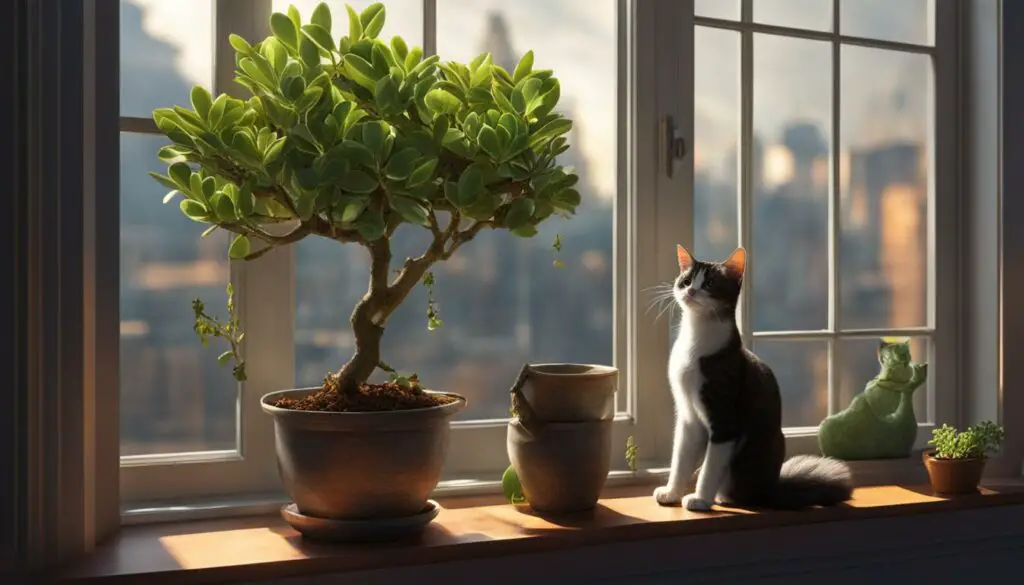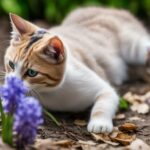As a cat owner, I am always concerned about the safety and well-being of my feline friend. Recently, I came across some information that left me wondering – are jade plants poisonous to cats? It’s a question that many cat owners may have, especially if they have jade plants in their homes. So, I decided to delve deeper into this topic and find out the truth.
Jade plants are popular houseplants known for their hardiness and easy growth. Their vibrant green leaves make them a beautiful addition to any indoor space. However, when it comes to cats, jade plants can be a potential danger. The leaves of the jade plant are highly toxic to cats, and ingestion of any part of the plant can lead to serious symptoms and even fatal toxicity.
It’s crucial for cat owners to be aware of the potential risks associated with jade plants and take necessary precautions to keep their feline friends safe. In this article, we will explore the toxicity of jade plants, how to identify them, the signs of jade plant poisoning in cats, and most importantly, how to keep our cats safe from these toxic houseplants.
Key Takeaways:
- Jade plants are highly toxic to cats, especially the leaves.
- Identifying jade plants is important to ensure your cat’s safety.
- Symptoms of jade plant poisoning in cats can include vomiting, lethargy, and weakness.
- There are precautions you can take to keep your cat safe from jade plants.
- Jade plants are not the only toxic houseplants for cats; be aware of other common toxic plants.
Identifying Jade Plants
Jade plants, also known as Baby Jade, Japanese rubber plant, Chinese rubber plant, or Jade trees, are popular houseplants with fleshy dark green rounded leaves that resemble rubber. These leaves can sometimes appear blueish-gray with red edges. Identifying jade plants is essential for cat owners to ensure they can recognize and keep their cats away from this toxic houseplant.
Characteristics of Jade Plants
When identifying jade plants, look for the following characteristics:
- Thick, glossy dark green leaves that are oval-shaped
- Leaves can grow up to three inches long
- Sometimes have a blueish-gray color with red edges
- Produces small star-shaped flowers in white and pink shades
- When grown outdoors, jade plants can reach up to six feet tall
- When grown indoors, they are typically smaller and sold in small succulent pots
By familiarizing yourself with these distinguishing features, you can easily identify jade plants and ensure the safety of your beloved feline companions.
| Characteristic | Description |
|---|---|
| Leaves | Thick, glossy dark green leaves that are oval-shaped and can grow up to three inches long |
| Color | Sometimes have a blueish-gray color with red edges |
| Flowers | Produces small star-shaped flowers in white and pink shades |
| Size | When grown outdoors, jade plants can reach up to six feet tall. When grown indoors, they are typically smaller and sold in small succulent pots |
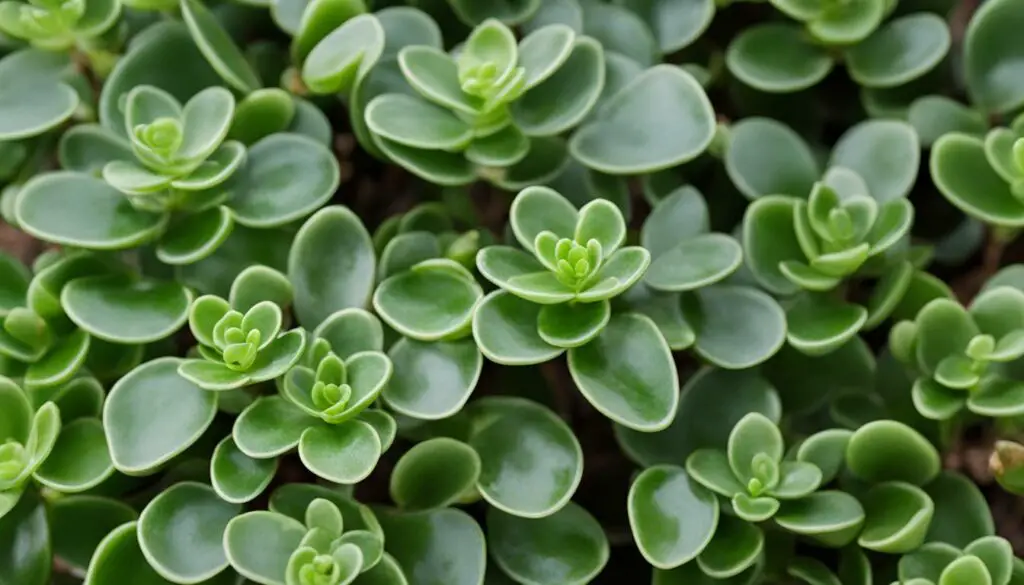
Identifying jade plants is important for cat owners to ensure they can recognize and keep their cats away from this toxic houseplant. By familiarizing yourself with the characteristics of jade plants, such as their thick, glossy dark green leaves, blueish-gray color, and star-shaped flowers, you can easily identify these plants and take the necessary precautions to ensure the safety of your feline friends.
Cats and Jade Plants
When it comes to the safety of our feline friends, it’s important to understand the potential dangers that certain plants can pose. Jade plants, known for their hardiness and appeal as houseplants, can actually be toxic to cats. It is believed that all parts of the jade plant, including the leaves, can be harmful to cats if ingested.
While the exact cause of toxicity in cats from jade plants is still unknown, it is crucial for cat owners to be vigilant and take precautions. Even chewing on the leaves can lead to serious reactions, making it a medical emergency that requires immediate veterinary attention.
As responsible pet owners, we need to be aware of the risks associated with jade plant toxicity and take necessary measures to keep our cats safe. This includes keeping jade plants out of reach and creating a cat-friendly environment that eliminates potential hazards. By doing so, we can ensure the wellbeing of our beloved feline companions.
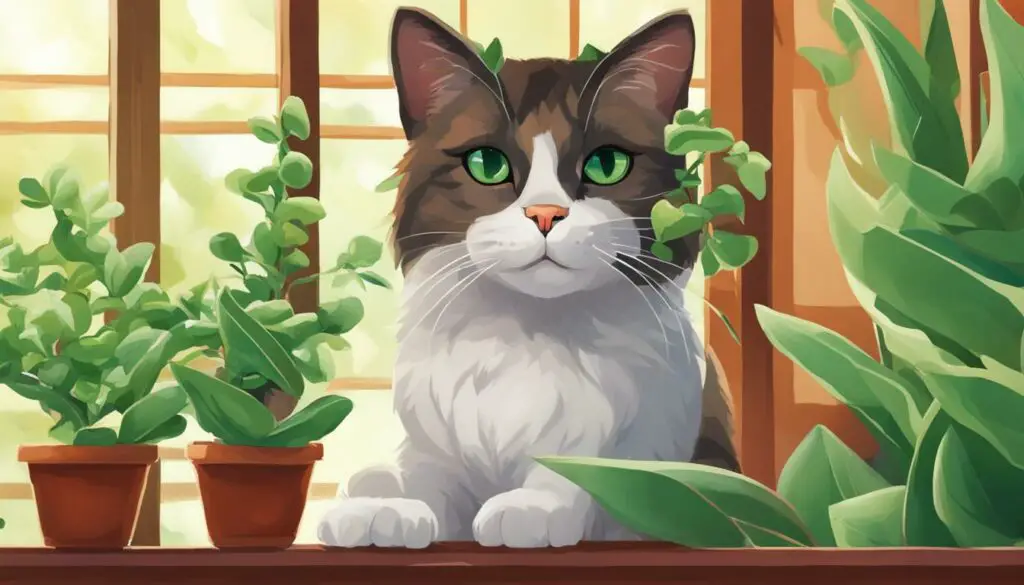
Signs of Jade Plant Poisoning in Cats
When it comes to jade plant toxicity in cats, it’s essential to be able to recognize the signs of poisoning. These symptoms can vary in severity and may include:
- Vomiting
- Depression
- Lack of grooming
- Incoordination
- Slowed heart rate
- Lethargy
- Weakness
- Excessive sleeping or hiding
- Increased aggression
If you notice any of these signs in your cat and suspect jade plant poisoning, it’s crucial to seek veterinary help immediately. While these symptoms may be indicative of other health issues as well, it’s better to err on the side of caution and get professional advice. Time is of the essence when it comes to treating jade plant poisoning in cats.
Keep in mind that jade plant toxicity can vary depending on the individual cat and the amount ingested. Some cats may experience mild symptoms, while others may develop severe reactions. Prompt veterinary attention can help determine the best course of action for your feline companion’s well-being.
Table: Comparative Analysis of Jade Plant Poisoning Symptoms in Cats
| Severity | Symptoms |
|---|---|
| Mild | Vomiting, depression, lack of grooming |
| Moderate | Incoordination, slowed heart rate, lethargy |
| Severe | Weakness, excessive sleeping or hiding, increased aggression |
As seen in the table above, the severity of jade plant poisoning symptoms can vary. It’s important to monitor your cat closely and seek prompt veterinary help if you notice any signs of poisoning.

Key Takeaways
Being knowledgeable about the signs of jade plant poisoning in cats is crucial for pet owners. By recognizing these symptoms, you can take swift action and ensure the well-being of your feline companion. Remember, any suspicion of jade plant poisoning should be treated as an emergency, and veterinary attention should be sought immediately.
The 7 Ways to Keep Your Cat Safe
As cat owners, we want to ensure the safety and well-being of our feline friends. One important aspect of cat safety is protecting them from toxic houseplants like jade plants. Here are seven ways to keep your cat safe from harmful plants:
Create a Cat-Friendly Environment
Make sure to keep toxic plants out of reach by placing them in areas that your cat cannot access. This includes high shelves, hanging baskets, or using plant stands. It’s also a good idea to secure windowsills and balcony areas to prevent your cat from nibbling on plants outdoors.
Use Deterrents
There are various deterrents available that can help keep your cat away from toxic plants. Spray deterrents with unpleasant scents or motion-activated deterrent devices can be effective in discouraging your cat from approaching and nibbling on plants.
Provide Safe Alternatives
Offering your cat safe alternatives like cat grass or catnip can divert their attention away from toxic plants. These feline-friendly plants are non-toxic and provide entertainment and stimulation for your cat.
Keep Fallen Leaves Picked Up
If you have jade plants or other toxic plants in your home, it’s important to regularly check for fallen leaves. Cats can be curious creatures and may try to play with or chew on fallen leaves. By promptly picking up fallen leaves, you can prevent accidental ingestion by your cat.
Create a Dedicated Plant Room
If you have a large collection of houseplants, consider designating a specific room or area as a plant room. This allows you to enjoy your plants while keeping them safely away from your curious feline companion.
Opt for Fake Plants
If you love the aesthetic of indoor plants but want to err on the side of caution, artificial plants can be a great alternative. Artificial plants provide the visual appeal without the risk of toxic ingestion.
Eliminate Toxic Plants
The best way to protect your cat from toxic plants is to eliminate them from your home and nearby outdoor areas entirely. Research cat-safe houseplants and choose feline-friendly options to ensure a safe environment for your cat to explore and play in.
By following these seven ways to keep your cat safe, you can create a cat-friendly environment and provide a safe and toxin-free space for your feline companion. Remember, always consult with your veterinarian if you suspect your cat has ingested a toxic plant or is displaying any unusual symptoms.
| Plant | Toxicity | Safe Alternative |
|---|---|---|
| Jade Plant | Toxic to cats | Cat grass or catnip |
| Aloe Vera | Toxic to cats | Spathiphyllum (Peace Lily) |
| Lilies | Highly toxic to cats | Spider Plant |
| Azaleas | Toxic to cats | Phalaenopsis Orchid |
| Rhododendrons | Toxic to cats | African Violet |
| Monstera Deliciosa | Toxic to cats | Money Plant (Pothos) |
Other Common Houseplants That are Toxic to Cats
While jade plants are known for their toxicity to cats, there are several other common houseplants that can also pose a threat to our feline friends. It’s important for cat owners to be aware of these plants and take steps to ensure their cats are not exposed to them. Here are some of the most common toxic houseplants for cats:
| Houseplant | Toxicity Level | Common Symptoms |
|---|---|---|
| Aloe Vera | Moderate to Severe | Vomiting, diarrhea, tremors, loss of appetite |
| Lilies | Severe | Vomiting, kidney failure, lethargy, loss of appetite |
| Azaleas & Rhododendrons | Moderate to Severe | Vomiting, diarrhea, difficulty breathing, drooling |
| Monstera Deliciosa | Moderate | Irritation of mouth, tongue, and lips |
| English Ivy | Moderate to Severe | Vomiting, diarrhea, abdominal pain, drooling |
| Pothos | Mild to Moderate | Irritation of mouth, tongue, and lips, vomiting, diarrhea |
| Dumb Cane | Moderate | Mouth irritation, excessive drooling, difficulty swallowing |
| Sago Palm | Severe | Vomiting, diarrhea, jaundice, liver failure, seizures |
It’s important to note that this list is not exhaustive, and there may be other toxic houseplants not mentioned here. If you suspect your cat has ingested any part of a toxic plant, it’s crucial to seek veterinary attention immediately. Prompt treatment can make a significant difference in the outcome for your cat.
To keep your cat safe, it’s best to eliminate toxic plants from your home and ensure that any outdoor areas where your cat may roam are also free from these plants. Providing safe alternatives like cat grass or catnip can also help fulfill your cat’s natural instincts while keeping them away from potentially dangerous plants.
How to Identify Jade Plant
Jade plants have distinct characteristics that make them easily identifiable. Here are some key features to look out for when trying to identify a jade plant:
Leaves:
The leaves of a jade plant are thick, glossy, and oval-shaped. They are typically dark green in color, although they can sometimes have a bluish-gray tint with red edges. The leaves grow in pairs along the stems and can reach up to three inches in length.
Flowers:
Jade plants produce small star-shaped flowers in shades of white and pink. These flowers usually bloom during the winter months and add a beautiful touch to the plant’s overall appearance.
Size:
When grown outdoors, jade plants can reach heights of up to six feet. However, when grown as indoor houseplants, they are generally smaller and sold in small succulent pots. It’s important to note that the size of a jade plant can vary depending on its age and growing conditions.
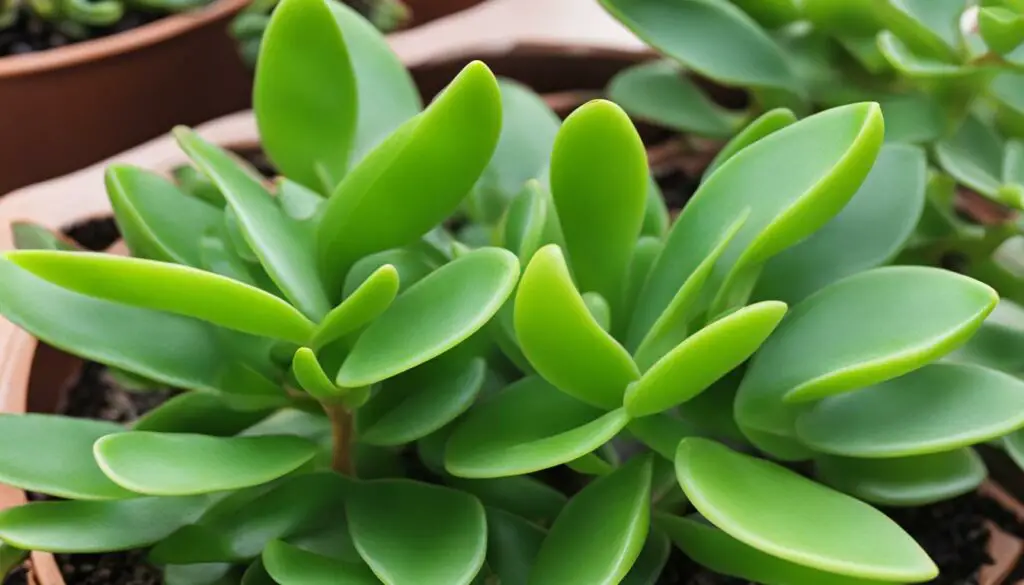
By familiarizing yourself with these identifying features, you’ll be able to easily recognize a jade plant. This knowledge is important for cat owners to ensure they can keep their feline friends safe from this toxic houseplant.
| Feature | Description |
|---|---|
| Leaves | Thick, glossy, oval-shaped, dark green with a bluish-gray tint and red edges |
| Flowers | Small star-shaped flowers in white and pink shades |
| Size | Up to 6 feet tall when grown outdoors, smaller when grown as indoor houseplants |
Remember, if you suspect that your cat has ingested any part of a jade plant, it’s important to seek immediate veterinary attention. The wellbeing of your feline companion should always be a top priority.
What is Jade Poisoning?
Jade poisoning refers to the condition caused by the consumption of jade plants by cats. It can lead to symptoms such as vomiting, diarrhea, abdominal pain, and in severe cases, even death. Prompt treatment is crucial to prevent fatal outcomes. Jade plants contain toxins that can be harmful to both humans and animals, and ingesting them should be treated as a medical emergency.
When a cat ingests any part of the jade plant, the toxic compounds present in the leaves can cause adverse reactions in their system. These toxins can disrupt the gastrointestinal tract, leading to vomiting and diarrhea. Additionally, the cat may experience abdominal pain and discomfort.
It’s important to note that the severity of jade poisoning can vary depending on factors such as the amount ingested and the individual cat’s sensitivity. Some cats may only exhibit mild symptoms, while others can experience more severe reactions.
If you suspect that your cat has ingested jade plants or is displaying any symptoms of jade poisoning, it is essential to seek immediate veterinary assistance. The veterinarian will be able to provide the necessary treatment and support to help your cat recover. Remember, early intervention is key in ensuring the best chances of a successful outcome.
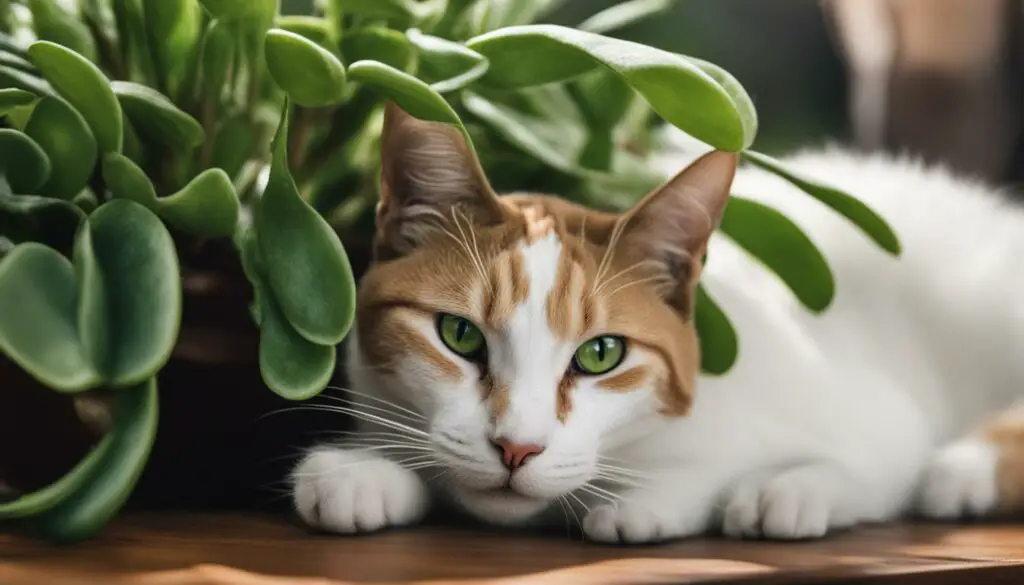
“Prompt treatment is crucial to prevent fatal outcomes.”
Causes of Jade Poisoning in Cats
Jade poisoning in cats occurs when a cat ingests any part of the jade plant, including the leaves. The exact cause of toxicity is still unknown, but it is believed that the plant contains toxic substances that can be harmful to cats. Even chewing on the leaves can lead to oral irritation and other symptoms. Cats are curious creatures, and their exploratory nature can sometimes put them at risk of encountering toxic plants like jade. Therefore, it is important for cat owners to take precautions to keep their feline friends safe.
One possible reason for jade plant poisoning in cats is their natural tendency to nibble on plants. Cats may be attracted to the bright green leaves of the jade plant and may unknowingly ingest the toxic substances present in the plant. Additionally, the plant’s succulent and attractive appearance may make it a tempting target for curious cats. It’s important to note that not all cats will have severe reactions if they do not swallow the plant, but it’s always better to err on the side of caution and prevent any potential exposure.
Another factor that can contribute to jade poisoning in cats is the inability to accurately determine if a cat has ingested any part of the plant. Cats may exhibit subtle symptoms or may not show any signs of poisoning until it has progressed to a severe stage. This makes it challenging for cat owners to identify the cause of their cat’s illness and highlights the importance of seeking veterinary attention if there is any suspicion of jade poisoning.
Diagnosing Jade Poisoning in Cats
When it comes to diagnosing jade poisoning in cats, it is essential to seek the expertise of veterinary professionals. They possess the knowledge and tools to identify and interpret the clinical signs and symptoms of jade plant toxicity that may not be apparent to pet owners.
Cats are masters at hiding their pain and discomfort, making it even more crucial to rely on professional guidance. Veterinary professionals will perform a thorough examination, including evaluating vital signs, conducting blood tests, and monitoring organ function. These diagnostic measures help determine the severity of the poisoning and guide the appropriate treatment plan.
Seeking veterinary assistance is crucial in diagnosing jade poisoning in cats. Don’t hesitate to reach out to a veterinarian if you suspect your cat has ingested any part of a jade plant.
Diagnosing jade poisoning in cats is a complex process that requires professional expertise. Prompt action is vital to ensure the best chances of recovery for your feline companion.
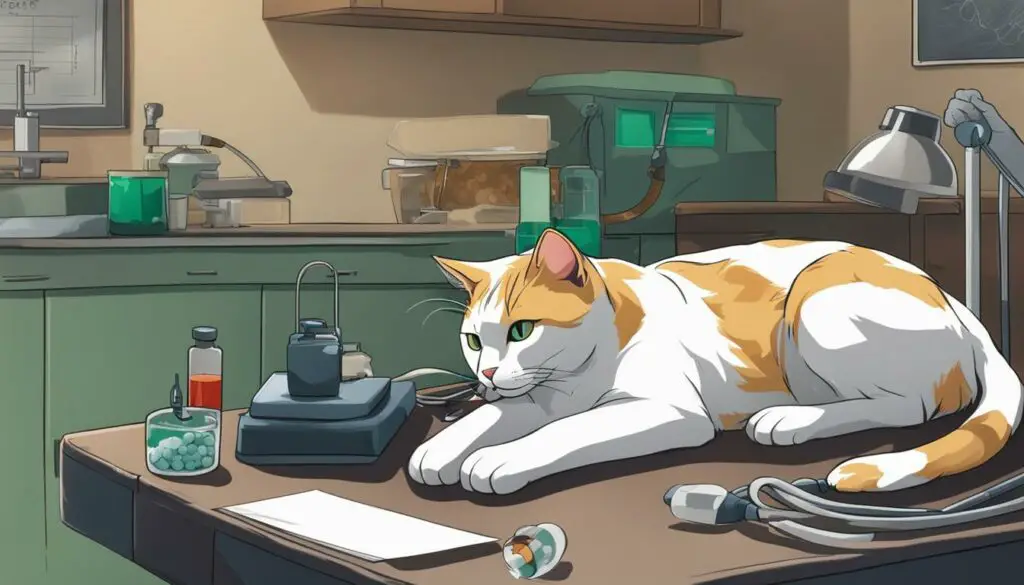
| Symptoms of Jade Poisoning in Cats |
|---|
| Vomiting |
| Diarrhea |
| Loss of appetite |
| Slow heart rate |
| Skin irritation |
| Upset stomach |
| Drooling |
| Kidney failure (in severe cases) |
Recognizing the symptoms of jade poisoning in cats is crucial for timely diagnosis and intervention. If you observe any of these symptoms in your cat, contact your veterinarian immediately.
Symptoms of Jade Poisoning
Jade plant poisoning in cats can lead to a range of symptoms that can vary in severity. It’s important for cat owners to be aware of these symptoms to promptly recognize and seek veterinary help if their cat has ingested any part of the jade plant.
“My cat began vomiting and had diarrhea after nibbling on the leaves of a jade plant. I didn’t realize the danger until I noticed other signs like a slow heart rate and drooling. I rushed him to the vet, where they confirmed jade poisoning and started immediate treatment.” – Cat owner testimonial
Common symptoms of jade plant poisoning in cats include gastrointestinal upset such as vomiting and diarrhea, loss of appetite, slow heart rate, skin irritation, upset stomach, drooling, and more. In severe cases, kidney failure can occur, leading to more serious consequences. Prompt veterinary assistance is necessary to ensure proper treatment and the best chances of recovery for the affected cat.
It’s important to note that symptoms may not always appear immediately after ingesting the jade plant. It may take time for the toxins to affect the cat’s system. Therefore, even if a cat shows no immediate signs of poisoning, it’s still crucial to seek veterinary attention if there is a suspicion of exposure to the plant.
| Symptoms of Jade Poisoning in Cats |
|---|
| Vomiting |
| Diarrhea |
| Loss of appetite |
| Slow heart rate |
| Skin irritation |
| Upset stomach |
| Drooling |
| Kidney failure (in severe cases) |
Remember, if you suspect or witness any of these symptoms in your cat after exposure to a jade plant, it’s imperative to seek immediate veterinary assistance. Early intervention can greatly improve the chances of a positive outcome and save your cat’s life.
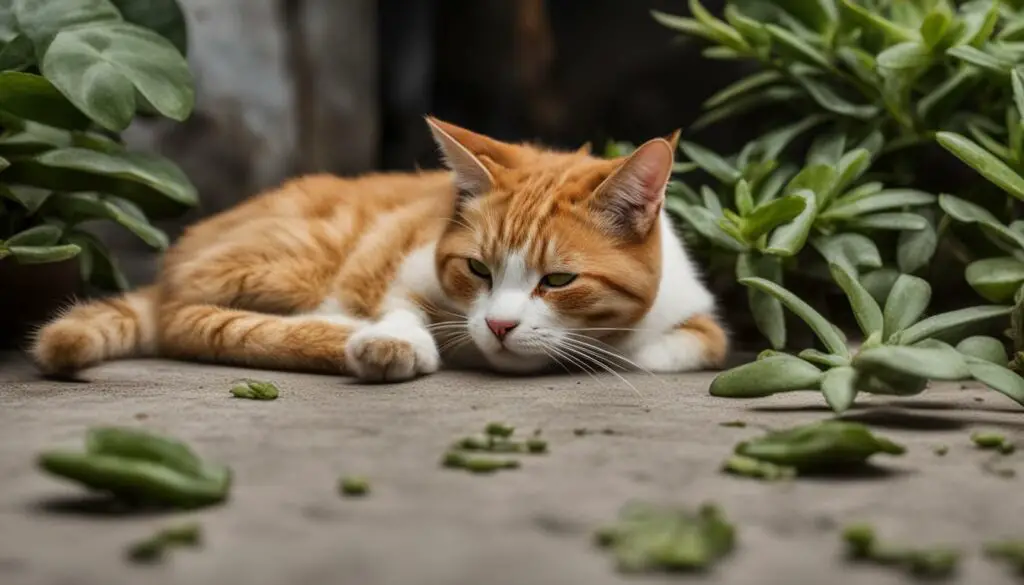
Treatment of Jade Poisoning
When a cat has been poisoned by a jade plant, prompt and appropriate treatment is crucial for their recovery. The severity of the poisoning will determine the course of action taken by veterinary professionals. Common treatments for jade poisoning in cats may include:
- Gastric lavage: This procedure involves flushing the cat’s stomach with a sterile solution to remove any remaining plant material.
- Activated charcoal: Administering activated charcoal can help absorb toxins in the cat’s gastrointestinal tract, preventing further absorption into the bloodstream.
- Intravenous fluids: Fluid therapy is often necessary to support the cat’s hydration and flush out any toxins.
It’s important to note that severe cases of jade toxicity can be fatal, especially if left untreated or if the poisoning is detected late. Therefore, immediate veterinary care is needed to increase the chances of a successful recovery.
During the treatment phase, it’s essential for cat owners to closely follow their veterinarian’s instructions and adhere to any prescribed medications or dietary restrictions. Regular follow-up appointments may also be necessary to monitor the cat’s progress and make any necessary adjustments to the treatment plan.
By seeking professional help and providing prompt treatment, most cats have a good chance of making a full recovery from jade poisoning. However, prevention is always the best approach, and cat owners should take precautions to ensure their feline friends are kept safe from toxic plants like jade.
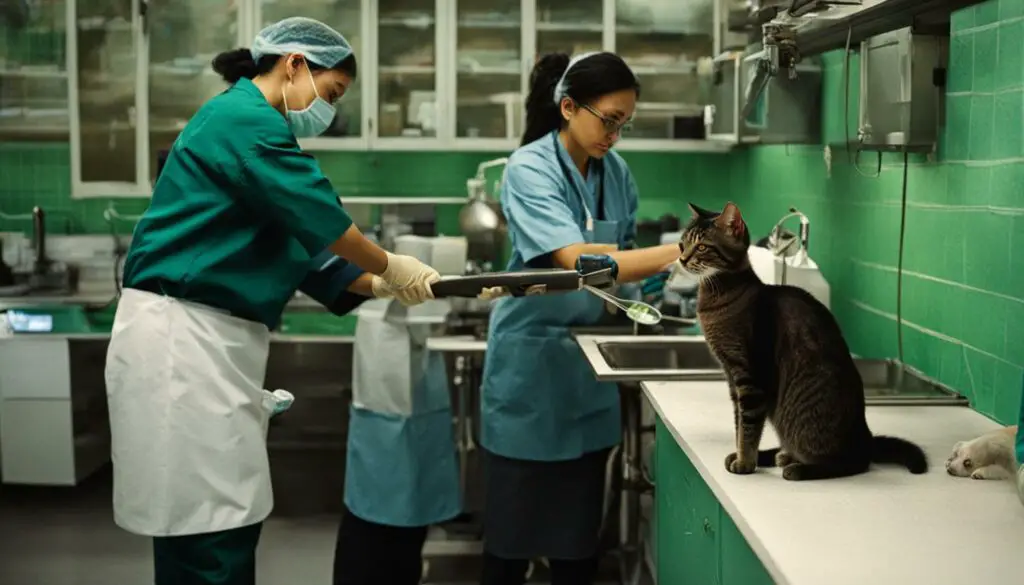
| Treatment Methods | Description |
|---|---|
| Gastric lavage | Flushing the cat’s stomach with a sterile solution to remove any remaining plant material. |
| Activated charcoal | Administering activated charcoal to absorb toxins in the cat’s gastrointestinal tract. |
| Intravenous fluids | Fluid therapy to support hydration and flush out toxins. |
Conclusion
In conclusion, it is important to understand that jade plants are indeed poisonous to cats. These beautiful houseplants may be popular for their hardiness, but their leaves can pose a serious threat to our feline friends. Cat owners must be aware of the potential risks and take necessary precautions to ensure the safety and well-being of their cats.
To keep cats safe from jade plants and other toxic houseplants, it is crucial to eliminate such plants from the home. Providing safe alternatives like cat grass or catnip can help redirect their attention and prevent them from chewing on dangerous leaves. If any signs of jade poisoning are observed, immediate veterinary assistance should be sought.
Remember, the health and safety of our beloved cats should always be a top priority. By being proactive and knowledgeable about the potential dangers of jade plants, we can ensure a happy and safe environment for our feline companions.
FAQ
Are jade plants poisonous to cats?
Yes, jade plants are highly toxic to cats.
How do I identify a jade plant?
Jade plants have fleshy dark green rounded leaves that resemble rubber and can sometimes appear blueish-gray with red edges.
What are the symptoms of jade plant poisoning in cats?
Symptoms of jade plant poisoning in cats can include vomiting, depression, lack of grooming, incoordination, slowed heart rate, lethargy, weakness, excessive sleeping or hiding, increased aggression, and more.
How can I keep my cat safe from jade plants?
To keep cats safe from jade plants, you can keep toxic plants out of reach, use deterrent sprays or motion-activated deterrents, provide safe alternatives like cat grass or catnip, keep fallen leaves picked up, create a dedicated plant room, opt for fake plants, and eliminate toxic plants from the home and nearby outdoor areas.
Are jade plants the only toxic houseplants for cats?
No, there are several other common houseplants that can be toxic to cats, including aloe vera, lilies, azaleas, rhododendrons, monstera deliciosa, English ivy, pothos, dumb cane, and sago palm.
How do I identify a jade plant?
Jade plants have thick, glossy dark green leaves that are oval-shaped and can grow up to three inches long. They sometimes have a blueish-gray color with red edges. The plant also produces small star-shaped flowers in white and pink shades.
What is jade poisoning?
Jade poisoning refers to the condition caused by the consumption of jade plants by cats. It can lead to symptoms such as vomiting, diarrhea, abdominal pain, and in severe cases, even death.
What causes jade poisoning in cats?
The exact cause of jade poisoning in cats is still unknown, but it is believed that all parts of the jade plant, including the leaves, can be toxic to cats.
How is jade poisoning in cats diagnosed?
Veterinary professionals are best equipped to diagnose jade poisoning in cats. They can look for clinical signs and symptoms of toxicity that may not be apparent to pet owners.
What is the treatment for jade poisoning in cats?
The treatment for jade poisoning in cats may vary depending on the severity of the poisoning. It may include gastric lavage, activated charcoal, and intravenous fluids.
Source Links
- https://www.hepper.com/are-jade-plants-toxic-to-cats/
- https://wagwalking.com/cat/condition/jade-plant-poisoning-1
- https://www.backyardgardenlover.com/are-jade-plants-poisonous-to-cats/

